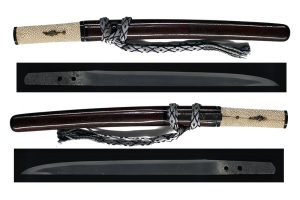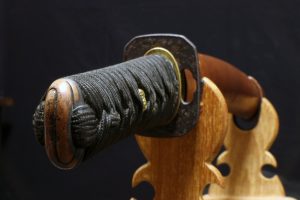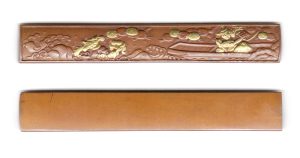説明
「刀姿 sword figure」
鎬造り庵棟、身幅重尋常、鳥居反り中鋒。茎は生で筋違い鑢がかかる、茎尻は栗尻。
「地鉄 jigane」
地鉄は板目肌が良く練れて、肌が流れて柾がかり、地沸見事に付き、ねっとりと強い地刃肌。
「刃紋 hamon」
刃紋は小沸出来の直刃、匂口深く冴え、金筋・砂流し入り乱れて働く。釯子は乱れ込み小丸に返る。
「特徴 detailed」
初代南紀重國は、もとは文珠四郎と称し、のちに九郎三郎重國と名乗り、紀州藩の御用刀匠として知られています。大和国手掻派の刀工・文珠四郎重次の子孫と伝えられています。重國は徳川家康に招かれて駿府に赴き、家康の死後はその十男・徳川頼宣に仕えました。元和5年(1619年)、頼宣が紀州へ移封されると、重國も和歌山へ移住しました。
南紀重國の作品には、相州伝の名工に倣った華やかな乱れ刃の作と、祖先から受け継いだ大和伝の直刃の作があり、幅広い作風を誇ります。日光東照宮に所蔵される南紀重國の刀は国宝に指定されており、彼は江戸時代初期を代表する名工の一人として高く評価されています。
本作は、身幅がしっとりとした鎬筋高く典型的な大和伝慶長から寛永頃の脇差体配です。さらに、本脇差は『日本刀工辞典』および雑誌『麗』に掲載されており、昭和16年2月に藤代によって発行された鑑定書も付属しています。
まさに戦前から高く評価されてきた、南紀重國の中の南紀重國と呼ぶにふさわしい優品です。
The first-generation Nanki Shigekuni, originally named Monju Shirō, later took the name Kurōsaburō Shigekuni and is known as the official swordsmith of the Kishu domain. He is said to have been a descendant of Monju Shirō Shigetsugu of the Tegai school in Yamato Province. Shigekuni was invited by Tokugawa Ieyasu to Sunpu, and after Ieyasu’s death, he served Ieyasu’s tenth son, Tokugawa Yorinobu. In 1619 (Genna 5), when Yorinobu was transferred to Kishu, Shigekuni also moved to Wakayama.
The works of Nanki Shigekuni include flamboyant midareba inspired by the great masters of the Sōshū tradition, as well as suguha in the Yamato style inherited from his ancestors. A sword by Nanki Shigekuni preserved at Nikkō Tōshōgū Shrine has been designated a National Treasure, and he is regarded as one of the foremost swordsmiths of the early Edo period.
This work features the typical wakizashi style of the Yamato tradition from the Keichō to Kan’ei periods, characterized by a well-proportioned, dignified form with a gently raised shinogi ridge.
Furthermore, this wakizashi is featured in both the Japanese Swordsmiths Dictionary and the magazine Rei, and it comes with an appraisal certificate issued by Fujishiro in February 1941 (Showa 16).
It is truly a masterpiece worthy of being called the Nanki Shigekuni among all Nanki Shigekuni blades — a highly esteemed work that has been recognized since before WW2.
「拵 Koshirae」
ハバキ(habaki) :素銅地、上蓋金着下蓋銀着の二重。
鞘(saya) :白鞘。
「刀剣の状態 condition of blade」
研:良好です。
傷:欠点に成るような傷は有りません。

































